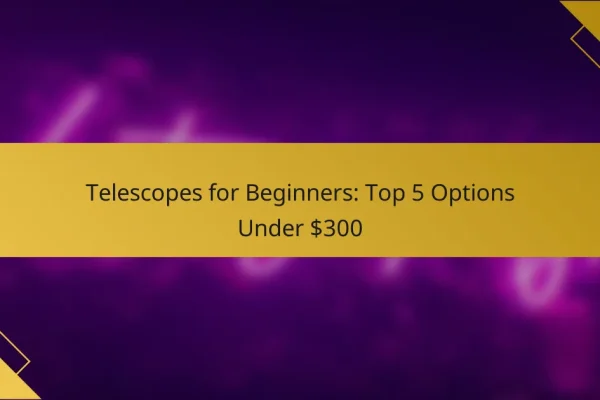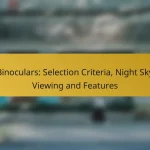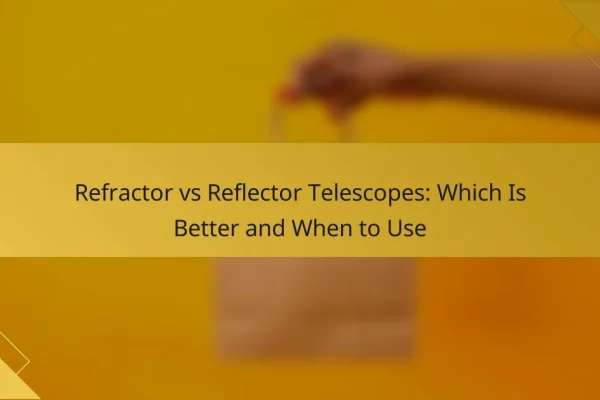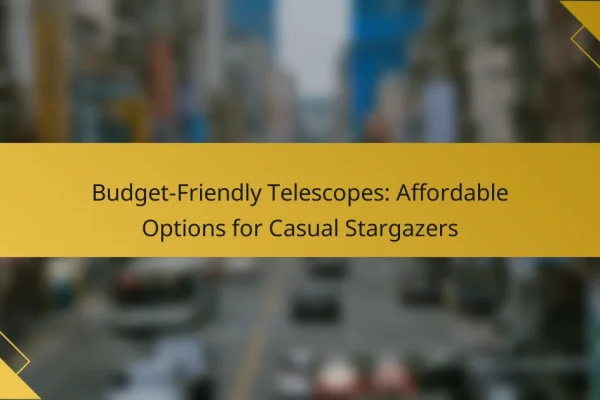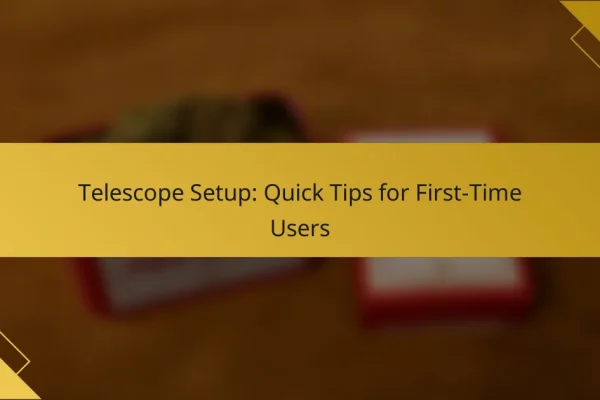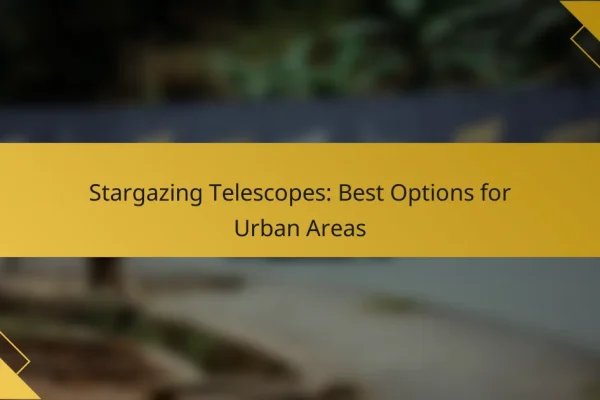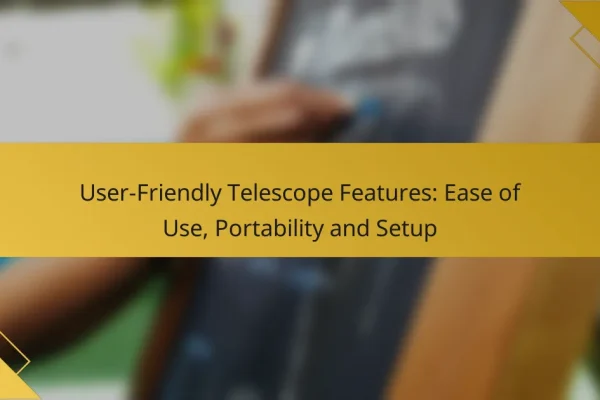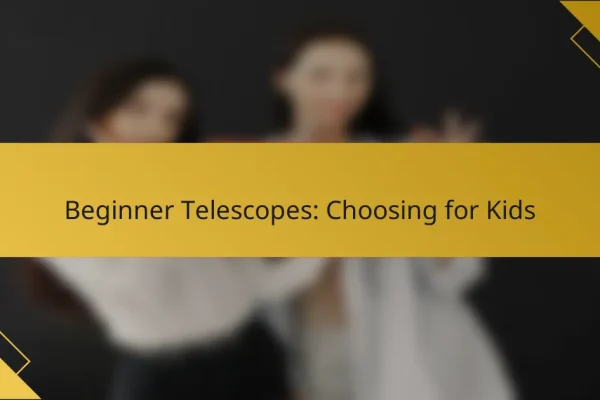What are the best telescopes for beginners?
The best telescopes for beginners are user-friendly, portable, and offer good optical quality at an affordable price. Popular choices include the Celestron AstroMaster 70AZ, Sky-Watcher Heritage 130P, and Orion StarBlast 4.5, each providing unique features suitable for novice astronomers.
Celestron AstroMaster 70AZ Telescope
The Celestron AstroMaster 70AZ is an excellent entry-level telescope, known for its ease of use and portability. With a 70mm aperture, it provides bright images of celestial objects, making it ideal for viewing the Moon and planets.
This telescope features a simple altazimuth mount, allowing for smooth movement in both vertical and horizontal directions. It comes with two eyepieces, offering different magnifications, which helps beginners learn about the effects of focal length on viewing experiences.
Sky-Watcher Heritage 130P
The Sky-Watcher Heritage 130P is a compact and powerful reflector telescope, featuring a 130mm aperture that captures more light for clearer images. Its tabletop design makes it easy to set up and use, perfect for backyard astronomy.
With a focal length of 650mm, this telescope is versatile for both planetary and deep-sky observations. It includes two eyepieces and a 2x Barlow lens, allowing users to explore a range of magnifications. Beginners should be aware that it may require occasional collimation to maintain optimal performance.
Orion StarBlast 4.5 Astro Reflector Telescope
The Orion StarBlast 4.5 is a popular choice among beginners due to its user-friendly design and impressive optics. With a 4.5-inch aperture, it provides bright and detailed views of the night sky, including star clusters and nebulae.
This telescope is portable and comes with a sturdy mount, making it easy to transport to different viewing locations. It includes two eyepieces and a wide field of view, which is beneficial for tracking moving objects. New users should familiarize themselves with the setup process to maximize their stargazing experience.
How to choose a beginner telescope?
Choosing a beginner telescope involves considering key factors like aperture size, mount types, and portability. These elements will significantly impact your observing experience and help you select a telescope that meets your needs.
Consider aperture size
Aperture size refers to the diameter of the telescope’s main lens or mirror, which determines how much light the telescope can gather. For beginners, a telescope with an aperture of at least 70mm is recommended for decent views of celestial objects.
Larger apertures, such as 100mm to 150mm, provide brighter and clearer images, allowing for better observation of faint objects. However, they may also increase the cost and weight of the telescope.
Evaluate mount types
The mount type affects how stable and easy to use the telescope is. There are mainly two types: altazimuth and equatorial mounts. Altazimuth mounts are simpler and easier for beginners, allowing for up-and-down and left-and-right movement.
Equatorial mounts are more complex but are beneficial for tracking celestial objects as they move across the sky. Beginners should weigh the ease of use against the potential for more advanced tracking capabilities.
Check portability and weight
Portability is crucial for beginners who may want to take their telescope to different locations. Lightweight telescopes, typically under 10 kg, are easier to transport and set up, making them ideal for casual stargazing.
Consider the size of the telescope when collapsed and whether it fits in your vehicle. If you plan to travel frequently, a compact design will enhance your overall experience.
What accessories do beginners need for telescopes?
Beginners should consider several essential accessories to enhance their telescope experience. Key items include a finderscope, a variety of eyepieces, and star charts or apps to aid in locating celestial objects.
Finderscope
A finderscope is a small, low-power telescope mounted on the main telescope to help locate objects in the sky. It typically has a wider field of view, making it easier to find celestial bodies before zooming in with the main telescope. Beginners should ensure the finderscope is properly aligned with the main telescope for effective use.
When selecting a finderscope, consider models with illuminated reticles for better visibility in low-light conditions. A finderscope with a magnification of around 5x to 10x is usually sufficient for beginners.
Eyepieces
Eyepieces are crucial for determining the magnification and field of view of your telescope. Beginners should start with a set of eyepieces that offer a range of focal lengths, typically from low to high magnification. A good starting point is to have at least one low-power eyepiece (around 25mm) and one high-power eyepiece (around 10mm).
When choosing eyepieces, consider the quality of the optics, as better coatings can enhance image clarity. Avoid very high magnifications initially, as they can lead to shaky images and a narrow field of view, making it difficult to locate objects.
Star charts or apps
Star charts or astronomy apps are invaluable tools for beginners to identify stars, planets, and constellations. These resources provide detailed maps of the night sky, helping users locate celestial objects based on their location and time of year. Many apps also include augmented reality features, allowing users to point their devices at the sky to see labels for stars and constellations.
When selecting a star chart or app, look for user-friendly interfaces and features that suit your level of experience. Some popular apps may offer free versions, while others might require a small fee for advanced features. Regularly using these tools can significantly enhance your stargazing experience.
Where can beginners buy telescopes in the US?
Beginners can purchase telescopes from various online retailers that offer a wide selection and competitive prices. Key options include major e-commerce platforms and specialty stores that focus on photography and optics.
Amazon
Amazon is a popular choice for beginners looking to buy telescopes due to its extensive range and user reviews. You can find telescopes at various price points, from budget-friendly options around $100 to more advanced models exceeding $1,000.
When shopping on Amazon, pay attention to customer ratings and reviews to gauge the quality of the telescope. Look for options with good return policies, as this can be helpful if the product does not meet your expectations.
B&H Photo Video
B&H Photo Video is a well-known retailer specializing in photography and videography equipment, including telescopes. They offer a curated selection of telescopes suitable for beginners, often with knowledgeable staff available to assist with questions.
Prices at B&H typically range from a few hundred to several thousand dollars, depending on the features and brand. Their website often includes detailed product descriptions and specifications, making it easier to compare different models.
OpticsPlanet
OpticsPlanet focuses on outdoor gear and optics, providing a solid selection of telescopes for beginners. They often have sales and discounts, which can make purchasing more affordable.
When browsing OpticsPlanet, consider using their filters to narrow down options based on your budget and desired features. Their customer service is known for being helpful, so don’t hesitate to reach out with questions before making a purchase.
What are common mistakes beginners make with telescopes?
Beginners often make several mistakes when using telescopes that can hinder their stargazing experience. Common issues include ignoring light pollution, not using a sturdy tripod, and overlooking maintenance, all of which can significantly affect visibility and enjoyment.
Ignoring light pollution
Light pollution is a major barrier for beginners trying to observe celestial objects. It occurs when artificial light brightens the night sky, making it difficult to see faint stars and other astronomical features. To mitigate this, choose a location away from city lights, ideally in rural areas or designated dark sky parks.
Using filters designed to reduce light pollution can also help enhance visibility. Additionally, planning observations during new moon phases can improve the clarity of the night sky, allowing for a better viewing experience.
Not using a sturdy tripod
A sturdy tripod is essential for stable viewing through a telescope. Beginners often underestimate the importance of a solid base, which can lead to shaky images and frustration. Invest in a high-quality tripod that can support the weight of your telescope and withstand wind or minor movements.
When setting up, ensure that the tripod legs are fully extended and securely locked. This will prevent wobbling and allow for a more enjoyable experience while observing celestial objects.
Overlooking maintenance
Regular maintenance is crucial for keeping telescopes in optimal condition. Beginners frequently neglect tasks such as cleaning lenses and checking for alignment, which can degrade performance over time. Make it a habit to inspect your telescope periodically for dust, dirt, or any signs of wear.
When cleaning, use appropriate materials like microfiber cloths and lens cleaning solutions to avoid scratches. Additionally, recalibrating the telescope’s alignment before major observing sessions can ensure accurate tracking of celestial objects.
How to set up a telescope for the first time?
Setting up a telescope for the first time involves a few key steps to ensure optimal viewing. Start by selecting a stable location away from bright lights and obstructions, then follow the manufacturer’s instructions for assembly and alignment.
Choosing the right location
Selecting the right location is crucial for effective telescope use. Look for a dark area away from city lights, ideally with a clear view of the sky. Elevated positions, such as hills or rooftops, can reduce atmospheric interference.
Assembling the telescope
Carefully follow the assembly instructions provided with your telescope. Typically, this includes attaching the mount to the tripod, securing the optical tube, and installing the finderscope. Ensure all parts are tightened but avoid over-tightening, which can damage components.
Aligning the telescope
Alignment is essential for accurate tracking of celestial objects. Start by pointing the telescope at a bright star or planet and use the finderscope to center it in view. Adjust the telescope’s settings according to the manufacturer’s guidelines to ensure proper alignment.
Focusing the telescope
Once aligned, focus the telescope by slowly turning the focus knob until the object appears sharp. If using multiple eyepieces, start with a lower magnification for easier viewing, then switch to higher magnifications for detailed observations. Remember to refocus as you change eyepieces.
